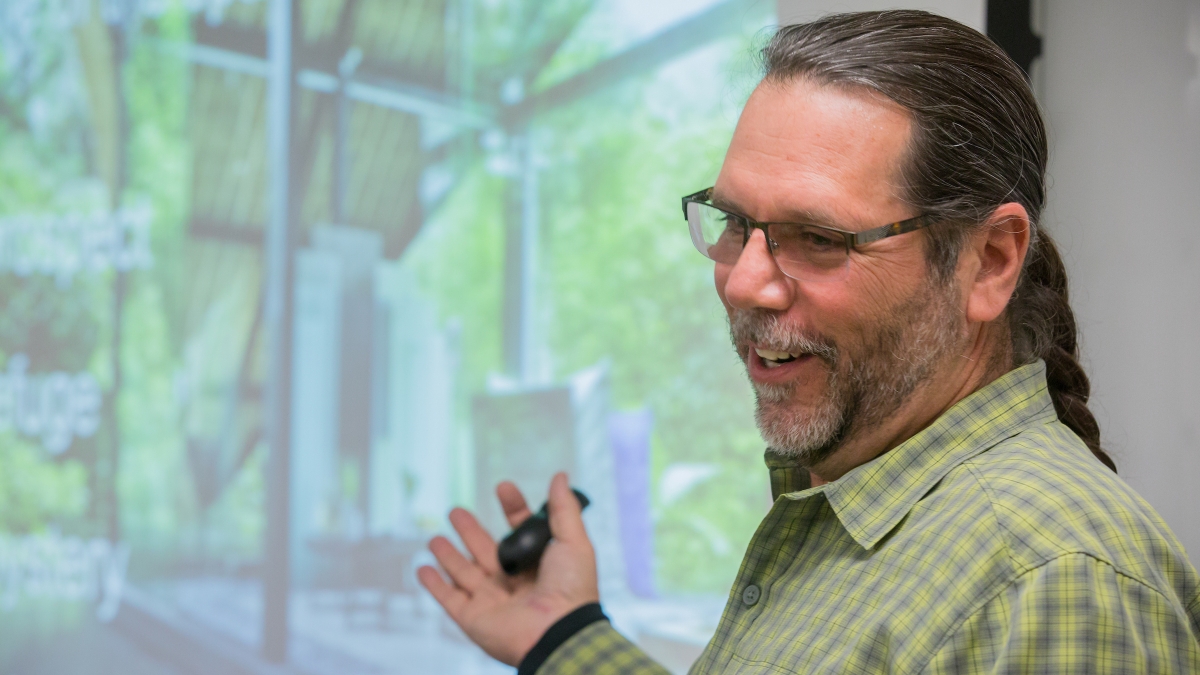Biophilic design: The art of nature
ASU adjunct faculty say bringing nature into design has physical, mental health benefits

When Joe Zazzera first walked onto floor of a telecommunications plant, he had one thought: “I can’t do this.”
In the windowless room, surrounded by barrels of chemicals and buzzing machinery, Zazzera was completely cut off from the natural world he loves.
Now, as a practitioner of biophilicLove of natural life. design, he works to bring nature inside, enhancing productivity, reducing stress and improving well-being.
Zazzera, founder of Plant Solutions, and Sonja Bochart, an interior designer who integrates principles of biophilia into her work, lectured on the topic yesterday at Arizona State University. Zazzera and Bochart are also adjunct faculty at ASU.
“Nature brings great value to our lives,” Bochart said. “Connection to the land is biophilia. … There’s a wild quality in nature we’re drawn to.”
The idea is simple. When you’re hiking or watching a nature video, you feel better. Blood pressure drops and parasympathetic healing activates. Sterile modern buildings such as office towers cut us off from that. And we spend, according to Bochart, 90 percent of our time indoors.
“You bring in light and life, and it fills us,” she said.
Adjunct faculty member Sonja Bochart talks with a couple of people following a lunchtime lecture on biophilia and biomimicry on Thursday, Feb. 2. The topics relate to the integration of nature into home, school and business environments. She is an interior designer who integrates principles of biophilia into her work. Photo by Charlie Leight/ASU Now
Biophilic design elements include environmental features like natural materials, water, and “living walls” planted with moss or hanging plants; natural shapes and forms; natural patterns and processes, including changing copper patinas. A place-based relationship is also important. A building in Phoenix should not be interchangeable with one in Seattle or Chicago.
Bochart called biophilia a balance between art and science, and it’s something science has plenty of evidence to support.
Views of nature reduce post-operative hospital stays by 8.5 percent, and lower blood pressure and heart rate. Morning sun reduces hospital stays of bipolar patients 26 to 30 percent. Natural ventilation reduces sick time 57 percent and hospital stays almost 35 percent.
In learning, natural daylight raises test scores and heightens learning rates. The presence of water improves concentration and memory restoration. A visual connection to nature improved mental engagement and attentiveness.
Retailers, pay attention. Day lighting increased sales per square foot and increased average sales 6 percent. The presence of trees increased willingness to pay 15 to 25 percent more for the same items.
In offices, indoor plants reduce sick building syndromes 21 percent. A view of nature can result in 6 to 7 percent faster call handling time at call centers. And natural ventilation can cut sick leave more than 57 percent and doctor visits almost 17 percent.
Biophilic design is “not just bringing plants indoors,” Zazzera said. As the founder of Plant Solutions Inc., he designs living walls, indoor atriums, living plant scapes and moss wall art.
Biophilic design increases the overlap between the human and natural worlds.
“Hopefully, in the future there won’t be a difference,” Zazzera said. “Corporations are waking up to this.”
The lecture was sponsored by the Julie Ann Wrigley Global Institute of Sustainability as part of their Sustainability Series, where speakers discuss a range of environmental, social, and economic topics. The series is free and open to the public.
Top photo: Adjunct faculty member Joe Zazzera talks with around 50 people at a lunchtime lecture on biophilia and biomimicry on Feb. 2. Photo by Charlie Leight/ASU Now
More Environment and sustainability

ASU scientist studies how bans, regulations on food technology affect consumer acceptance, perceptions
How do people process scientific developments with outside influences, warnings, biases and others’ opinions filtering in? That’s the question Caitlin Drummond Otten, environmental social scientist…

ASU team's research leads to new law protecting mobile-home dwellers
Arizona Gov. Katie Hobbs signed a law earlier this month that guarantees mobile-home owners’ right to install cooling measures, thanks in large part to the work of an Arizona State University team.…

ASU event discusses hopeful future for a decarbonized economy
The economic landscape and jobs market are changing faster than ever, with cutting-edge technologies, workplace adaptations and evolving industries driving the need for transformation across the…
